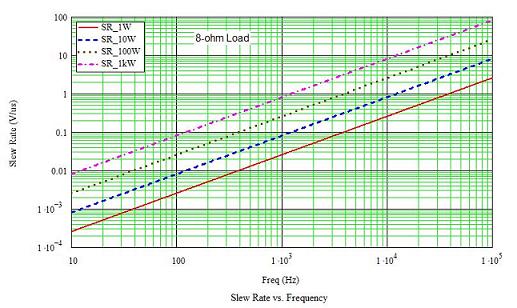I have seen a few discussions about slew rate and thought it might be a worthwhile thread. Slew rate is defined as the amount a signal (voltage, current, power, whatever) changes in a given time period. For the math types, it is the first derivative with respect to time. For a single-frequency sinusoid, e.g. a single tone, the slew rate (SR) is given by
SR = 2*pi*f*A where
pi = 3.14159…
f = frequency
A = amplitude
The amplitude is the peak (pk) value of the signal. For example, a 1 Vrms signal is 2.828 Vpp or 1.414 Vpk. At 1 kHz, the slew rate is 8,886 V/s, or 0.0089 V/us (Volts per microsecond, a typical unit). This is the maximum slew rate, which occurs at the sinusoidal signal’s center crossing. It decreases away from the center, though stays fairly close to the maximum value for most of the amplitude range (it does decrease to zero at the very top and bottom).
Since slew rate seems to be more a concern for power amplifiers, I calculated the slew rate for various power levels (rms) into an 8-ohm load and plotted it versus frequency below. The log-log plot presents the slew rate as a straight line at each power level (1, 10, 100, and 1k W).

The slew rate may be lower than some expected given the 50 to 100 V/us rates specified by some manufacturers. At 20 kHz, a 100 W signal only requires 5.03 V/us slew rate. There are pros and cons with higher slew rates:
A few pros about high slew rate:
The cons tend to mirror the pros:
HTH - Don
SR = 2*pi*f*A where
pi = 3.14159…
f = frequency
A = amplitude
The amplitude is the peak (pk) value of the signal. For example, a 1 Vrms signal is 2.828 Vpp or 1.414 Vpk. At 1 kHz, the slew rate is 8,886 V/s, or 0.0089 V/us (Volts per microsecond, a typical unit). This is the maximum slew rate, which occurs at the sinusoidal signal’s center crossing. It decreases away from the center, though stays fairly close to the maximum value for most of the amplitude range (it does decrease to zero at the very top and bottom).
Since slew rate seems to be more a concern for power amplifiers, I calculated the slew rate for various power levels (rms) into an 8-ohm load and plotted it versus frequency below. The log-log plot presents the slew rate as a straight line at each power level (1, 10, 100, and 1k W).

The slew rate may be lower than some expected given the 50 to 100 V/us rates specified by some manufacturers. At 20 kHz, a 100 W signal only requires 5.03 V/us slew rate. There are pros and cons with higher slew rates:
A few pros about high slew rate:
- Greater design margin for high-frequency signals.
- A higher slew rate allows the amplifier to better control high-frequency ringing in the load (speaker).
- Higher slew may require higher bandwidth, which can make it easier to close the feedback loop without instability.
The cons tend to mirror the pros:
- High slew rates can push design margin to the edge, decreasing amplifier stability.
- High slew rate can cause excessive high-frequency content, potentially damaging drivers. If the speakers cannot respond quickly enough, power turns to heat that can damage or destroy the drivers.
- Greater bandwidth and/or fast edges (possible with a high slew rate) can cause high-frequency peaking and ringing, or even oscillation, with certain loads. Higher bandwidth also means more noise, and more (higher-frequency) distortion components.
HTH - Don
Last edited:

